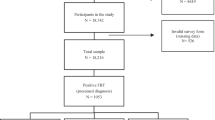Abstract
Background
School screening for scoliosis is a powerful tool that can be used to identify children who may have scoliosis. There have been no reports on the recent prevalence of idiopathic scoliosis in Japan since 1988.
Methods
A 5-year epidemiologic study was performed to determined the prevalence of idiopathic scoliosis, the curve magnitude, the distribution of this magnitude, and the sex ratio in school children. Between 2003 and 2007, a total of 255,875 children aged 11–14 years were screened.
Results
A total of 3,424 children were found to be positive as a result of Moiré topography. With radiographic examination, 2,225 (65.0%) children with a Cobb angle of 10° or more were detected. The overall prevalence rate in schoolchildren 11–14 years of age with Cobb angles of 10° or more was 0.87%. The prevalence rate in girls increased from 0.78% at the age of 11–12 years to 2.51% at the age of 13–14 years. For boys, the prevalence rates were 0.04% at the age of 11–12 years and 0.25% at the age of 13–14 years. The overall ratio of girls to boys with scoliosis was 11:1. The ratio of girls to boys was 17:1 at the age of 11–12 years and 10:1 at the age of 13–14 years.
Conclusions
The majority of the curves fell in the range of 10°–19°. There was a slight increase in the prevalence rates of children with a curve of high magnitude (≥20°) as compared to the prevalence rate in 1988. We suggest that school screening for scoliosis is effective for early detection; however, it is first necessary to review and optimize the target groups.

Similar content being viewed by others

References
Weinstein SI, Zavala DC, Ponseti IV. Idiopathic scoliosis; long-term follow-up and prognosis in untreated patients. J Bone Joint Surg (Am). 1981;63:702–12.
Wong HK, Hui JHP, Rajan U, Chia HP. Idiopathic scoliosis in Singapore schoolchildren: a prevalence study 13 years into the screening program. Spine. 2005;30:1188–96.
Renshaw TS. Screening school children for scoliosis. Clin Orthop. 1988;229:26–33.
Torell G, Nordwall A, Nachemson A. The changing pattern of scoliosis treatment due to effective screening. J Bone Joint Surg (Am). 1981;63:337–41.
Brooks Hi, Azen SP, Gerberg E, Brooks R, Chan I. Scoliosis: a prospective epidemiological study. J Bone Joint Surg (Am). 1975;57:968–72.
Burwell RG, Webb JK, More EJ. School screening for scoliosis. Lancet. 1981;2:863.
Grossman TW, Mazur JM, Cummings RJ. An evaluation of the Adams forward-bending test and the scoliometer in a scoliosis screening setting. J Pediatr Orthop. 1995;15:535–8.
Laulund T, Sojbjerg O, Horlyck E. Moiré topography in school-screening for adolescent idiopathic scoliosis. Int J Epidemiol. 1982;11:101–11.
Ohtsuka Y, Yamagata M, Arai S, Kitahara H, Minami S. School screening for scoliosis by the Chiba university medical school screening program—results of 1.24 million students over an 8-year period. Spine. 1988;13:1251–6.
Rogala EJ, Drummond DS, Gurr J. Scoliosis incidence and natural history: a prospective epidemiological study. J Bone Joint Surg (Am). 1978;60:173–6.
Soucacos PN, Soucacos PK, Zacharis KC, Beris AE, Xenakis TA. School screening for scoliosis: a prospective epidemiological study in northwestern and central Greece. J Bone Joint Surg (Am). 1997;79:1498–503.
Willner S. Moiré topography: a method for school screening of scoliosis. Arch Orthop Trauma Surg. 1979;95:181–5.
Willner S, Uden A. A prospective prevalence study of scoliosis in Southern Sweden. Acta Orthop Scand. 1982;53:233–7.
Lonstein JE, Bjorklund S, Wanninger MH. Voluntary school screening for scoliosis in Minnesota. J Bone Joint Surg (Am). 1982;64:481–8.
Daruwarlla JS, Balasubrmanian P. Moiré topography in scoliosis: its accuracy in detecting the site and size of the curve. J Bone Joint Surg (Br). 1985;67:211–3.
Karachalios T, Sofianos J, Roidis N, Sapkas G, Korres D, Nikolopoulos K. Ten-year follow-up evaluation of a school screening program for scoliosis. Spine. 1999;24:2318–24.
Sahlstrand T. The clinical value of Moiré topography in the management of scoliosis. Spine. 1986;11:409–17.
Mooreland MS, Barce C, Pope MH. Moiré topography in scoliosis: pattern recognition and analysis. In: Moreland MS, Pope MH, Armstrong CWD, editors. Moiré fringe topography and spinal deformity. New York: Pergamon Press; 1981. p. 171–85.
String AJ, Howel D, Millner PA. Late-onset idiopathic scoliosis in children six to fourteen years old: cross-sectional prevalence study. J Bone Joint Surg (Am). 1996;78:1330–6.
Zhang G, Li Z, Wei X. Screening for scoliosis among schoolchildren in Bei**g. Chin Med J. 1988;101:151–5.
Nakazawa T, Takaso M, Imura T, Itoman M, Moriya H, Isobe K, Ohtsuka Y, Akazawa T. Morbirity rate study on school screening for scoliosis in Tokyo. Spinal Deform. 2006;1:45–49 (in Japanese).
Nakazawa T, Takaso M, Imura T, Ueno M, Shintani R, Saito W, Toyama M. School screening for idiopathic scoliosis in Tokyo-results in 2007. J Spine Res. 2010;1:1947–1951.
Nash CL, Gregg EC, Brown RH. Risks of exposure to X-rays in patients undergoing long-term treatment for scoliosis. J Bone Joint Surg (Am). 1979;61:371–4.
Smyrnis PN, Valavanis J, Alexopoulous A, Siderakis G, Giannestras NJ. School screening for scoliosis in Athens. J Bone Joint Surg (Br). 1979;61:215–7.
Csongradi JJ, Bleck EE. Moiré moirtopography: use of in scoliosis observation. In: Drerupp B, Frobin W, Hierzholder E, editors. Moiré fringe topography and spinal deformity. Stuttgart: Gustav Fischer Verlag, vol. 3, pp. 141–8.
Acknowledgments
The authors thank Yoshinori Ohtsuka (the Adviser of the scoliosis screening section of the Tokyo Health Service Association) and Hiroto Saito (the Chief Director of the scoliosis screening section of the Tokyo Health Service Association). The authors did not receive and will not receive any benefits and funding from any commercial party related directly or indirectly to the subject of this article.
Author information
Authors and Affiliations
Corresponding author
About this article
Cite this article
Ueno, M., Takaso, M., Nakazawa, T. et al. A 5-year epidemiological study on the prevalence rate of idiopathic scoliosis in Tokyo: school screening of more than 250,000 children. J Orthop Sci 16, 1–6 (2011). https://doi.org/10.1007/s00776-010-0009-z
Received:
Accepted:
Published:
Issue Date:
DOI: https://doi.org/10.1007/s00776-010-0009-z



